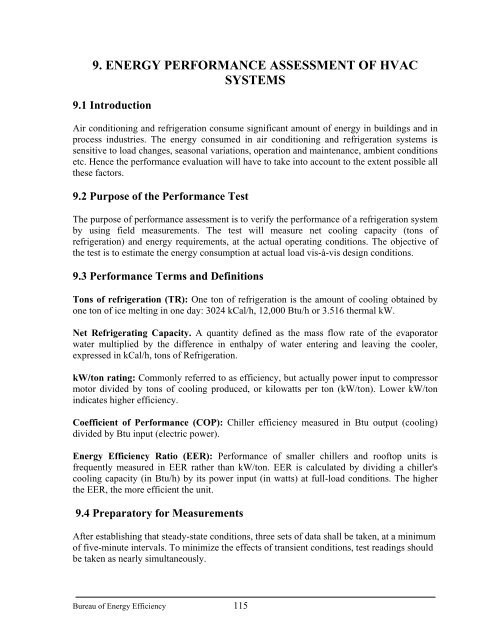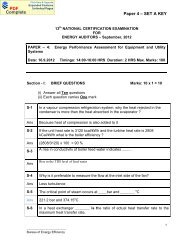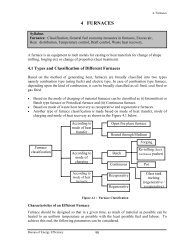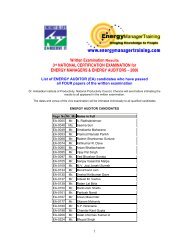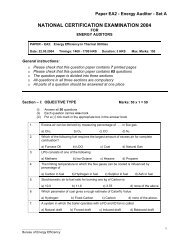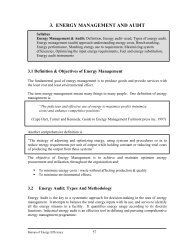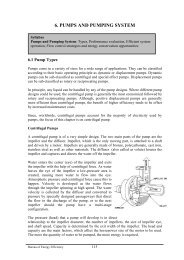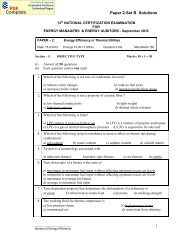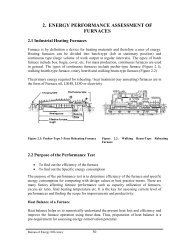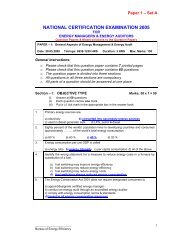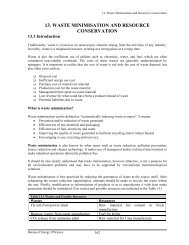9. Energy Performance Assessment of HVAC Systems
9. Energy Performance Assessment of HVAC Systems
9. Energy Performance Assessment of HVAC Systems
You also want an ePaper? Increase the reach of your titles
YUMPU automatically turns print PDFs into web optimized ePapers that Google loves.
<strong>9.</strong> ENERGY PERFORMANCE ASSESSMENT OF <strong>HVAC</strong><br />
SYSTEMS<br />
<strong>9.</strong>1 Introduction<br />
Air conditioning and refrigeration consume significant amount <strong>of</strong> energy in buildings and in<br />
process industries. The energy consumed in air conditioning and refrigeration systems is<br />
sensitive to load changes, seasonal variations, operation and maintenance, ambient conditions<br />
etc. Hence the performance evaluation will have to take into account to the extent possible all<br />
these factors.<br />
<strong>9.</strong>2 Purpose <strong>of</strong> the <strong>Performance</strong> Test<br />
The purpose <strong>of</strong> performance assessment is to verify the performance <strong>of</strong> a refrigeration system<br />
by using field measurements. The test will measure net cooling capacity (tons <strong>of</strong><br />
refrigeration) and energy requirements, at the actual operating conditions. The objective <strong>of</strong><br />
the test is to estimate the energy consumption at actual load vis-à-vis design conditions.<br />
<strong>9.</strong>3 <strong>Performance</strong> Terms and Definitions<br />
Tons <strong>of</strong> refrigeration (TR): One ton <strong>of</strong> refrigeration is the amount <strong>of</strong> cooling obtained by<br />
one ton <strong>of</strong> ice melting in one day: 3024 kCal/h, 12,000 Btu/h or 3.516 thermal kW.<br />
Net Refrigerating Capacity. A quantity defined as the mass flow rate <strong>of</strong> the evaporator<br />
water multiplied by the difference in enthalpy <strong>of</strong> water entering and leaving the cooler,<br />
expressed in kCal/h, tons <strong>of</strong> Refrigeration.<br />
kW/ton rating: Commonly referred to as efficiency, but actually power input to compressor<br />
motor divided by tons <strong>of</strong> cooling produced, or kilowatts per ton (kW/ton). Lower kW/ton<br />
indicates higher efficiency.<br />
Coefficient <strong>of</strong> <strong>Performance</strong> (COP): Chiller efficiency measured in Btu output (cooling)<br />
divided by Btu input (electric power).<br />
<strong>Energy</strong> Efficiency Ratio (EER): <strong>Performance</strong> <strong>of</strong> smaller chillers and ro<strong>of</strong>top units is<br />
frequently measured in EER rather than kW/ton. EER is calculated by dividing a chiller's<br />
cooling capacity (in Btu/h) by its power input (in watts) at full-load conditions. The higher<br />
the EER, the more efficient the unit.<br />
<strong>9.</strong>4 Preparatory for Measurements<br />
After establishing that steady-state conditions, three sets <strong>of</strong> data shall be taken, at a minimum<br />
<strong>of</strong> five-minute intervals. To minimize the effects <strong>of</strong> transient conditions, test readings should<br />
be taken as nearly simultaneously.<br />
Bureau <strong>of</strong> <strong>Energy</strong> Efficiency 115
<strong>9.</strong> <strong>Energy</strong> <strong>Performance</strong> <strong>Assessment</strong> <strong>of</strong> <strong>HVAC</strong> <strong>Systems</strong><br />
<strong>9.</strong>5 Procedure<br />
<strong>9.</strong>5.1 To determine the net refrigeration capacity<br />
The test shall include a measurement <strong>of</strong> the net heat removed from the water as it passes<br />
through the evaporator by determination <strong>of</strong> the following:<br />
a. Water flow rate<br />
b. Temperature difference between entering and leaving water<br />
The heat removed from the chilled water is equal to the product <strong>of</strong> the chilled water flow rate,<br />
the water temperature difference, and the specific heat <strong>of</strong> the water is defined as follows<br />
The net refrigeration capacity in tons shall be obtained by the following equation:<br />
m x Cp<br />
x(<br />
t in<br />
− t<br />
Net refrigeration Capacity (TR) =<br />
3024<br />
Where m – mass flow rate <strong>of</strong> chilled water, kg/hr<br />
c p - Specific heat, kcal/kg o C<br />
t in – Chilled water temperature at evaporator inlet o C<br />
- Chilled water temperature at evaporator outlet o C<br />
t out<br />
The accurate temperature measurement is very vital in refrigeration and air conditioning and<br />
least count should be at least one decimal.<br />
Methods <strong>of</strong> measuring the flow<br />
In the absence <strong>of</strong> an on-line flow meter the chilled water flow can be measured by the following<br />
methods<br />
out<br />
• In case where hot well and cold well are available, the flow can be measured from the<br />
tank level dip or rise by switching <strong>of</strong>f the secondary pump.<br />
• Non invasive method would require a well calibrated ultrasonic flow meter using<br />
which the flow can be measured without disturbing the system<br />
• If the waterside pressure drops are close to the design values, it can be assumed that<br />
the water flow <strong>of</strong> pump is same as the design rated flow.<br />
<strong>9.</strong>5.2 Measurement <strong>of</strong> compressor power<br />
The compressor power can be measured by a portable power analyser which would give<br />
reading directly in kW.<br />
If not, the ampere has to be measured by the available on-line ammeter or by using a tong<br />
tester. The power can then be calculated by assuming a power factor <strong>of</strong> 0.9<br />
Power (kW) = √3 x V x I x cosφ<br />
)<br />
Bureau <strong>of</strong> <strong>Energy</strong> Efficiency 116
<strong>9.</strong> <strong>Energy</strong> <strong>Performance</strong> <strong>Assessment</strong> <strong>of</strong> <strong>HVAC</strong> <strong>Systems</strong><br />
<strong>9.</strong>5.3 <strong>Performance</strong> calculations<br />
The energy efficiency <strong>of</strong> a chiller is commonly expressed in one <strong>of</strong> the three following ratios:<br />
1.Coefficient <strong>of</strong> performance<br />
COP = kW refrigeration effect<br />
kW input<br />
2. <strong>Energy</strong> efficiency ratio<br />
3. Power per Ton<br />
EER = Btu/h refrigeration effect<br />
Watt input<br />
kW/Ton = kW input<br />
Tons refrigeration effect<br />
First calculate the kW/ton rating from the measured parameters.<br />
a)<br />
kW/ton rating =<br />
Measuredcompressorpower, kW<br />
Net refrigeration capacity (TR)<br />
Use this data to calculate other energy efficiency parameters with the following relations<br />
COP = 0.293 EER EER = 3.413 COP<br />
kW/Ton = 12 / EER<br />
EER = 12 / (kW/Ton)<br />
kW/Ton = 3.516 / COP<br />
COP = 3.516 / (kW/Ton)<br />
* Source : American Refrigeration Institute<br />
b)<br />
Coefficien t <strong>of</strong> performance(COP) =<br />
3.516<br />
kW/ton rating<br />
c)<br />
<strong>Energy</strong> Efficiency Ratio( EER)<br />
=<br />
12<br />
kW / tonrating<br />
<strong>9.</strong>5.4 <strong>Performance</strong> evaluation <strong>of</strong> air conditioning systems<br />
For centralized air conditioning systems the air flow at the air handling unit (AHU) can be<br />
measured with an anemometer. The dry bulb and wet bulb temperatures can be measured at<br />
the AHU inlet and outlet. The data can be used along with a psychrometric chart (Figure <strong>9.</strong>1)<br />
to determine the enthalpy (heat content <strong>of</strong> air at the AHU inelt and outlet)<br />
m x(<br />
hin − hout<br />
)<br />
Heat load ( TR)<br />
=<br />
4.18 x3024<br />
m – mass flow rate <strong>of</strong> air, kg/hr<br />
h in – enthalpy <strong>of</strong> inlet air at AHU, kJ/kg<br />
h out – enthalpy <strong>of</strong> outlet air at AHU, kJ/kg<br />
Bureau <strong>of</strong> <strong>Energy</strong> Efficiency 117
<strong>9.</strong> <strong>Energy</strong> <strong>Performance</strong> <strong>Assessment</strong> <strong>of</strong> <strong>HVAC</strong> <strong>Systems</strong><br />
Heat load can also be calculated theoretically by estimating the various heat loads, both<br />
sensible and latent, in the air-conditioned room (refer standard air conditioning handbooks).<br />
The difference between these two indicates the losses by way <strong>of</strong> leakages, unwanted loads,<br />
heat ingress etc.<br />
<strong>9.</strong>6 Measurements to be Recorded During the Test<br />
All instruments, including gauges and thermometers shall be calibrated over the range <strong>of</strong> test<br />
readings for the measurement <strong>of</strong> following parameters.<br />
Evaporator<br />
a. Temperature <strong>of</strong> water entering evaporator<br />
b. Temperature <strong>of</strong> water leaving evaporator<br />
c. Chilled water flow rates<br />
d. Evaporator water pressure drop (inlet to outlet)<br />
Compressor<br />
e. Power input to compressor electrical power, kW<br />
<strong>9.</strong>7 Example<br />
In a brewery chilling system, ethylene glycol is used a secondary refrigerant. The designed<br />
capacity is 40 TR. A test was conducted to find out the operating capacity and energy<br />
performance ratios. The flow was measured by switching <strong>of</strong>f the secondary pump and<br />
measuring the tank level difference in hot well.<br />
Measurements data:<br />
Temperature <strong>of</strong> ethylene glycol entering evaporator = (-) 1 o C<br />
Temperature <strong>of</strong> ethylene glycol leaving evaporator = (-) 4 o C<br />
Ethylene glycol flow rates<br />
= 13200 kg/hr<br />
Evaporator ethylene glycol pressure drop (inlet to outlet) = 0.7 kg/cm 2<br />
Power input to compressor electrical power, kW = 3<strong>9.</strong>5 kW<br />
Specific heat capacity <strong>of</strong> ethylene glycol<br />
= 2.34 kCal/kg o C<br />
Calculations<br />
m x Cp<br />
x(<br />
t<br />
Net refrigeration Capacity (TR)<br />
in<br />
− t<br />
=<br />
3024<br />
13200x 2.34 x(<br />
−1−<br />
( −4))<br />
Net refrigeration Capacity (TR) =<br />
3024<br />
= 30.65 TR<br />
out<br />
)<br />
Bureau <strong>of</strong> <strong>Energy</strong> Efficiency 118
<strong>9.</strong> <strong>Energy</strong> <strong>Performance</strong> <strong>Assessment</strong> <strong>of</strong> <strong>HVAC</strong> <strong>Systems</strong><br />
Measured compressor power, kW<br />
kW/ton rating =<br />
Net refrigeration capacity (TR)<br />
3<strong>9.</strong>5kW<br />
kW/ton rating = = 1.29kW /TR<br />
30.65 TR<br />
3.516<br />
Coefficien t <strong>of</strong> performance(COP) =<br />
kW/ton rating<br />
= 3.516<br />
1.29<br />
= 2.73<br />
<strong>Energy</strong> Efficiency Ratio( EER)<br />
=<br />
12<br />
kW / tonrating<br />
= 12<br />
1.29<br />
= <strong>9.</strong>3<br />
Bureau <strong>of</strong> <strong>Energy</strong> Efficiency 119
<strong>9.</strong> <strong>Energy</strong> <strong>Performance</strong> <strong>Assessment</strong> <strong>of</strong> <strong>HVAC</strong> <strong>Systems</strong><br />
Figure <strong>9.</strong>1 Psychrometric Chart<br />
Bureau <strong>of</strong> <strong>Energy</strong> Efficiency 120
<strong>9.</strong> <strong>Energy</strong> <strong>Performance</strong> <strong>Assessment</strong> <strong>of</strong> <strong>HVAC</strong> <strong>Systems</strong><br />
QUESTIONS<br />
1) What is meant by a ton <strong>of</strong> refrigeration?<br />
2) Define the terms net refrigeration capacity, COP, energy efficiency ratio.<br />
3) What is the relation between COP and kW/ton <strong>of</strong> refrigeration?<br />
4) How would you calculate the heat load for a room to be air-conditioned?<br />
5) If the power consumed by a refrigerating unit / ton <strong>of</strong> refrigeration is 2 kW then<br />
find energy efficiency ratio?<br />
REFERENCES<br />
1. Refrigeration and Air Conditioning by Richard C.Jordan & Gayle B.Priester –<br />
Prentice Hall <strong>of</strong> India pvt.ltd.<br />
2. Modern Air Conditioning Practice by Norman C.Harris – McGraw-Hill International<br />
Edition.<br />
Bureau <strong>of</strong> <strong>Energy</strong> Efficiency 121


